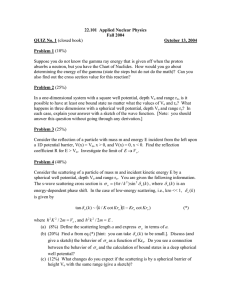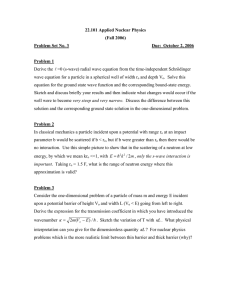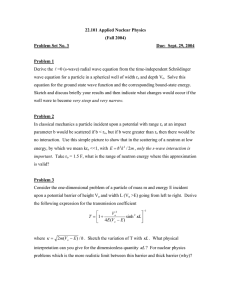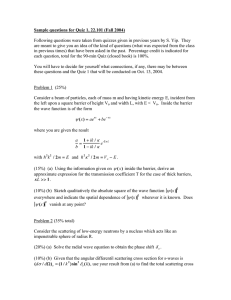Sample questions for Quiz 1, 22.101 (Fall 2006)
advertisement
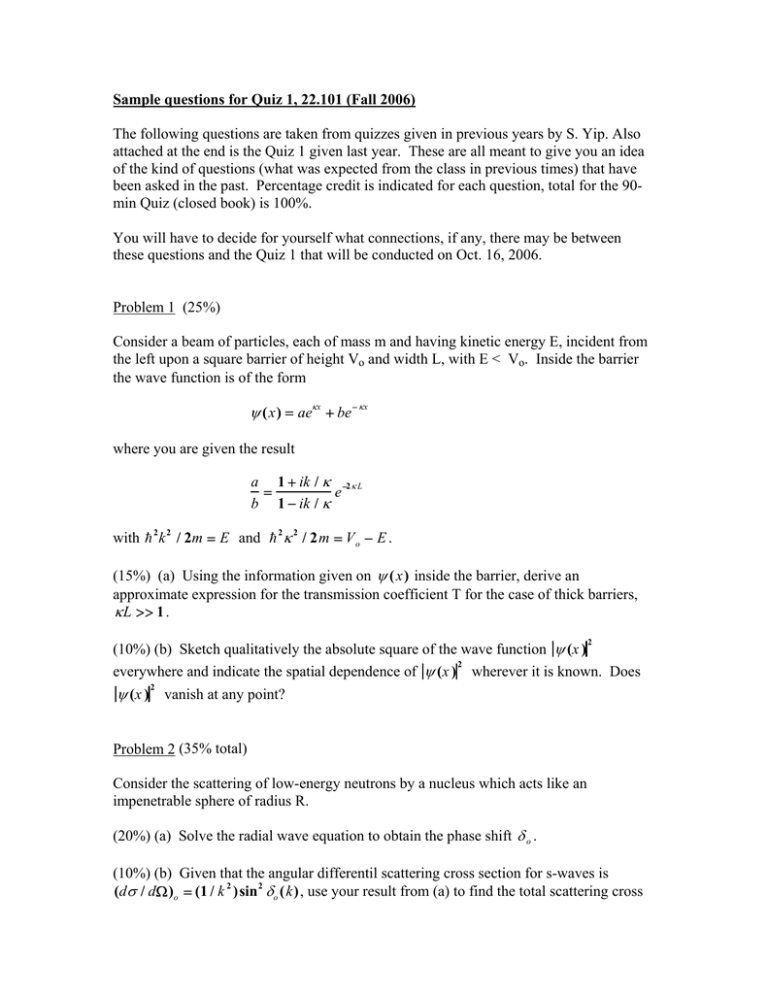
Sample questions for Quiz 1, 22.101 (Fall 2006) The following questions are taken from quizzes given in previous years by S. Yip. Also attached at the end is the Quiz 1 given last year. These are all meant to give you an idea of the kind of questions (what was expected from the class in previous times) that have been asked in the past. Percentage credit is indicated for each question, total for the 90 min Quiz (closed book) is 100%. You will have to decide for yourself what connections, if any, there may be between these questions and the Quiz 1 that will be conducted on Oct. 16, 2006. Problem 1 (25%) Consider a beam of particles, each of mass m and having kinetic energy E, incident from the left upon a square barrier of height Vo and width L, with E < Vo. Inside the barrier the wave function is of the form ψ (x) = aeκx + be − κx where you are given the result a 1 + ik / κ −2 κ L = e b 1 − ik / κ with h 2 k 2 / 2m = E and h 2 κ 2 / 2m = V o − E . (15%) (a) Using the information given on ψ ( x) inside the barrier, derive an approximate expression for the transmission coefficient T for the case of thick barriers, κ L >> 1 . (10%) (b) Sketch qualitatively the absolute square of the wave function ψ (x ) 2 everywhere and indicate the spatial dependence of ψ (x ) wherever it is known. Does 2 ψ (x ) vanish at any point? 2 Problem 2 (35% total) Consider the scattering of low-energy neutrons by a nucleus which acts like an impenetrable sphere of radius R. (20%) (a) Solve the radial wave equation to obtain the phase shift δ o . (10%) (b) Given that the angular differentil scattering cross section for s-waves is 2 2 (dσ / dΩ)o = (1 / k )sin δo (k) , use your result from (a) to find the total scattering cross section σ o . Suppose we apply this calculation to n-p scattering and use for R the radius of the deuteron, R = h m n E B , where mn is the neutron mass and EB is the ground state energy of the deuteron. Find R in unit of F (1 F = 10-13 cm), and σ o in barns. (5%) (c) Does your result agree with the experimental value of neutron scattering cross section of hydrogen? If not, explain the reason for the discrepancy. Problem 3 (25%) (a) Calculate the phase shift δo for s-wave scattering of a particle of mass m and incident energy E by a potential barrier V(r) = Vo, r < ro, and V(r) = 0, r > ro, with E < Vo. (b) Simplify your result by going to the limit of low-energy scattering. Examine the total scattering cross section σ = (4 π sin2 δ o ) / k 2 in this limit. Sketch σ as a function of k o ro , where k o2 = 2mVo / h2 and indicate the value of σ in the infinite barrier limit, k o ro → ∞ . Problem 4 (25%) Consider a one-dimensional wave equation with the potential − L1 ≤ x ≤ L1 (region 1) V1 − L2 ≤ x ≤ −L1 , L1 ≤ x ≤ L2 (region 2) 0 otherwise (region 3) -Vo V(x) = (a) Find the x-dependence of the wave function in each of the 3 regions for E < 0 (b) What are the boundary conditions to be applied at the interface? (You are asked to state the boundary conditions, but not to apply them.) Problem 5 (20%) A particle of mass m is just barely bound by a one-dimensional potential well of width L. Find the value of the depth Vo. Problem 6 (25%) Suppose you are given the result for the transmission coefficient T for the barrier penetration problem, one-dimensional barrier of height Vo extending from x=0 to x=L, ⎡ ⎤ Vo2 T = ⎢1 + sinh 2 KL ⎥ ⎣ 4E(Vo − E) ⎦ −1 where K 2 = 2m(Vo − E) / h 2 is positive (E < Vo). (a) From the expression given deduce T for the case E > Vo without solving the wave equation again. (b) Deduce T for the case of a square well potential from the result for a square barrier. Problem 7 (10%) Suppose you do not know the gamma ray energy that is given off when the proton absorbs a neutron, but you have the Chart of Nuclides. How would you go about determining the energy of the gamma (state the steps but do not do the math)? Can you also find out the cross section value for this reaction? Problem 8 (25%) In a one-dimensional system with a square well potential, depth Vo and range ro, is it possible to have at least one bound state no matter what the values of Vo and ro? What happens in three dimensions with a spherical well potential, depth Vo and range ro? In each case, explain your answer with a sketch of the wave function. [Note: you should answer this question without going through any derivation.] Problem 9 (25%) Consider the reflection of a particle with mass m and energy E incident from the left upon a 1D potential barrier, V(x) = Vo, x > 0, and V(x) = 0, x < 0. Find the reflection coefficient R for E > Vo. Investigate the limit of E → V o . Problem 10 (40%) Consider the scattering of a particle of mass m and incident kinetic energy E by a spherical well potential, depth Vo and range ro. You are given the following information. The s-wave scattering cross section is σ o = (4π / k 2 ) sin 2 δ o (k) , where δ o (k) is an energy-dependent phase shift. In the case of low-energy scattering, i.e., kro << 1, δ o (k) is given by tan δ o (k) ~ (k / K cot Kro )(1 − Kro cot Kro ) (*) where h 2 K 2 / 2m = Vo , and h 2 k 2 / 2m = E . (a) (8%) Define the scattering length a and express σ o in terms of a. (b) (20%) Find a from eq.(*) [hint: you can take δ o (k) to be small.]. Discuss (and give a sketch) the behavior of σ o as a function of Kro. Do you see a connection between the behavior of σ o and the calculation of bound states in a deep spherical well potential? (c) (12%) What changes do you expect if the scattering potential is a spherical barrier of height Vo with the same range (give a sketch)? 22.101 Applied Nuclear Physics Fall 2005 QUIZ No. 1 (closed book) October 17, 2005 Problem 1 (35%) (a) Calculate the thermal neutron scattering cross section of hydrogen using the phase shift method and the approximation that the scattering potential is an impenetrable sphere of radius R, where R is the nuclear radius of the deuteron (estimate by whatever reasonable means you like). Solve the s-wave radial wave equation to determine the phase shift, the corresponding angular differential cross section and the total cross section σ o . Evaluate the numerical value of σ o . (b) Compare you numerical value with the value obtained in the Lecture Notes by a similar calculation but not assuming the potential is an impenetrable sphere, and with the experimental value. Explain the implication of any agreement or discrepancy in this comparison. (c) Can you imagine a way to modify your calculation (still assuming the impenetrable sphere model for the interaction) to treat the neutron-proton scattering as spin dependent? Comment on whether the concept of the scattering length still applicable. Problem 2 (25%) Consider Problem 1 but now take the interaction potential to be a spherical barrier of height Vo and range ro = R (the deuteron nuclear radius), where Vo >> thermal energy. (a) Solve the s-wave radial wave equation to obtain the dispersion relation that involves the wavenumbers K, k and the phase shift δ o (k) , with h 2 K 2 / 2m = Vo and h 2 k 2 / 2m = E . Denote this relation as equation (*). (b) Define the scattering length a and find a from equation (*) [hint: you can take δ o (k) to be small]. (c) Give a sketch of σ o as a function of Kro. Discuss briefly and comment on whether your results in Problem 1 and 2 are consistent? Problem 3 (25%) Suppose in Problem 2 you replace the spherical barrier by a spherical well with depth Vo and the same range ro as before. Without going through the calculation in detail again, find the dispersion relation using your result from Problem 2(a). (In other words, how would you modify your equation (*)?) Give a sketch of the cross section σ o versus Kro, and discuss any difference in cross section behavior between a well and a barrier. Problem 4 (15%) Suppose you are now interested in bound-state solutions to the radial wave equation for the neutron-proton system. Without doing any detailed calculation (but you can point to any result in your calculations in Problems 1 through 3), what can you say about the existence of bound states for the two interactions in Problems 2 and 3? (Explain the underlying reason why the two problems may be different.)
